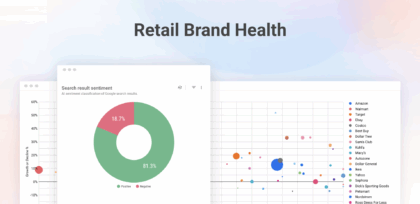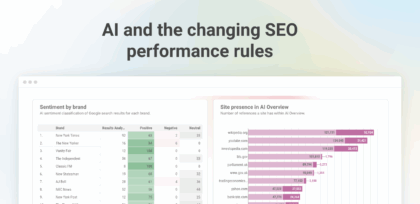How consumer search behaviour has changed in 2020
20 Oct 2020|4 MIN READ
It’s been an unpredictable year in retail, as it has been for life in general. As we approach what is traditionally the busiest time of the year for ecommerce, we look back at some retail trends for the year to date. Lockdowns, furloughs and restrictions on shops and other business premises have brought about huge changes in consumer search behaviour.
Using our consumer search data we have been tracking the search landscape and can see how people have reacted to events, and how this has affected key retail sectors.
Our new ‘A year in retail so far’ report looks at these retail trends, with a focus on homeware, electricals, fashion and beauty.
How search behaviour has changed in 2020
Looking across the four sectors mentioned, we can see the contrasting fortunes of each when compared with the same period in previous years.
The immediate effect of lockdown was to drive people online in greater numbers. All four sectors we’ve focused on experienced year on year search growth.
It was most pronounced for the homeware market with search activity increasing by 75%, as people turned to DIY projects as a way to make use of lockdown, or to buy the things they needed to work from home. The same principle is true for electricals, which grew 65%.
Fashion is one sector which hasn’t experienced huge growth during lockdown, with searches increasing by just 6%. Within the fashion sector, ‘going out’ clothing has been less popular, but people have been buying loungewear and more casual clothing instead.
[icon-cta-banner colour='jazzberry-jam' headline="A year in retail so far report" icon='/wp-content/uploads/2018/12/MAR-1715_retail-white.svg' cta_action='/market-analysis-reports/a-year-in-retail/' cta_text='Download the report']
[/icon-cta-banner]
Retail trends | search behaviour over time | Retail combined landscape
Image source: Pi Market Intelligence
The most searched items during lockdown reflect customers’ needs at the time. This chart shows searches from April 2019 to June 2020 and the increase in search volume year on year.
People wanted things to do, hence DIY and games searches, or to keep fit, or to cut their own hair now that hairdressers were closed.
Most searched terms Q2 2020 | Search volume | Google UK
The Nintendo Switch was the most popular product search, as people looked for something to do while they had time to spare.
They were also in short supply, so this volume of searches reflects the effort people made to search again and again in the hope of securing one.
[icon-cta-banner colour='jazzberry-jam' headline="A year in retail so far report" icon='/wp-content/uploads/2018/12/MAR-1715_retail-white.svg' cta_action='/market-analysis-reports/a-year-in-retail/' cta_text='Download the report']
[/icon-cta-banner]
Homeware search volumes and behaviour
Searches for homeware normally begin to rise in Spring, as the warmer weather inspires people to work in their gardens and begin some DIY tasks.
We can see spikes in search interest from 2019 beginning in March and peaking in May. This year though, interest in most homeware categories started to rise earlier in the year, and peaked much higher.
Retail trends | search behaviour over time | Homeware landscape

Image source: Pi Market Intelligence
Interest in gardening and DIY rose rapidly during March, and was by far the biggest growth area, with search volumes 149% higher for Q2 2020 than the previous year.
Comparing the product searches from Q2 2019 to Q2 2020 we can see a shift to garden entertainment items. Faced with the prospect of spending more time at home, people decided to spend money on products that would make their gardens more enjoyable.
There was a massive increase in searches for hot tubs, from just over 600,000 in Q2 2019 to more than five million in Q2 2020.
Some brands benefitted more than others from this search behaviour. B&Q (diy.com) increased its search share of voice, thanks in part to offering many of the most searched products.
The most dominant sites across the homeware search landscape during Q3 2020 were Wayfair, Amazon and Argos, each with a share greater than 3.5%. This covers 8,615 search terms and more than 82,000 sites.
Share of voice | Homeware landscape | Google UK

Image source: Pi Market Leaders
[icon-cta-banner colour='jazzberry-jam' headline="A year in retail so far report" icon='/wp-content/uploads/2018/12/MAR-1715_retail-white.svg' cta_action='/market-analysis-reports/a-year-in-retail/' cta_text='Download the report']
[/icon-cta-banner]
Electricals search volumes and behaviour
As people looked for home entertainment during lockdown, searches within the computing categories, which covers laptops, home PCs and games consoles, rocketed beyond the levels normally only seen around Black Friday and Christmas.
Searches in this category grew by 122.17% year on year, while home appliance searches were up 66.39%.
Retail trends | search behaviour over time | Electrical landscape

Image source: Pi Market Intelligence
The products searched for are similar to Q2 2019, but with much higher overall search volumes, the exception being hair clippers.

Google, mainly through Shopping ads, takes the top spot for many electrical searches for commuting and home appliances, but Currys has increased its share of voice in this sector.
Share of voice | Electrical landscape | Google UK

Image source: Pi Market Leaders
This is also an area where publishers feature prominently. PC Mag and Tech Radar take the fourth and fifth spots here, mainly thanks to their authority in the computing space.
If the search results for your target keywords look like this, and users like to research products before committing to a purchase, then it’s a good idea to create content that helps the research process, such as detailed product guides, as well as plenty of customer reviews.
[icon-cta-banner colour='jazzberry-jam' headline="A year in retail so far report" icon='/wp-content/uploads/2018/12/MAR-1715_retail-white.svg' cta_action='/market-analysis-reports/a-year-in-retail/' cta_text='Download the report']
[/icon-cta-banner]
Fashion search volumes and behaviour
This is one area where we don’t see the peaks in search demand, and it has been a challenging year so far for this sector.
Searches for womenswear dipped during lockdown, and overall search volumes for Q2 2020 were 9% lower then for 2019. Volumes are beginning to pick up now though, as restrictions have eased.
One growth area was kidswear, as parents needed clothes when school uniforms aren't being worn every day. This category grew by 87%.
Retail trends | search behaviour over time | Fashion landscape

Image source: Pi Market Intelligence
Beauty search volumes and behaviour
Reflecting the need for a more DIY approach thanks to the closing of salons, beauty searches rose in every category during April and May, before dropping down again in June and July when businesses were able to reopen.
Retail trends | search behaviour over time | Beauty landscape

Image source: Pi Market Intelligence
YouTube has the greatest share of voice in this sector, closely followed by Superdrug, Amazon and Boots. It’s an area of the search landscape where video content can play a big role in customer acquisition.
Share of voice | Beauty landscape | Google UK

Image source: Pi Market Leaders
[icon-cta-banner colour='jazzberry-jam' headline="A year in retail so far report" icon='/wp-content/uploads/2018/12/MAR-1715_retail-white.svg' cta_action='/market-analysis-reports/a-year-in-retail/' cta_text='Download the report']
[/icon-cta-banner]
What can retailers learn from this data?
In a year of unprecedented challenge and change, it can be harder to predict consumer search behaviour according to normal patterns.
We still have what is normally peak season to come. November and December bring Black Friday and the Christmas shopping season, which tend to produce the biggest online retail sales for most sectors.
Balanced against this is the fact that many shoppers may have less to spend than usual - they may have spent big during lockdown, or have suffered a loss of income having been furloughed or unable to work.
There is also uncertainty about the prospect of further possible lockdowns or restrictions to physical shopping.
I think we’ll see significant numbers shop online as a result of this uncertainty. Added to this, many people may be reluctant to head to shops as they usually would around Christmas.
Some predictions suggest that overall retail spending may drop, but online will grow, which seems plausible.
The product search data shown here does provide some useful insight for retailers. The data tells us what matters to shoppers when their normal activities are restricted, so we could see a repeat of these search patterns in the run up to Christmas, as people look for products to keep them entertained indoors.
[icon-cta-banner colour='jazzberry-jam' headline="A year in retail so far report" icon='/wp-content/uploads/2018/12/MAR-1715_retail-white.svg' cta_action='/market-analysis-reports/a-year-in-retail/' cta_text='Download the report']
[/icon-cta-banner]
Watch our retail takeover webinar
Our Head of Marketing Sophie Moule, interviewed guests Ian Jindal, Founder & Editor in Chief of Internet Retailing, and Roman Sadowski, Senior SEO of Smyths Toys Superstores, on their predictions for Q4.
https://youtu.be/Rv2iR9fA2ec
Never miss a post
Join our mailing list and have our SEO news delivered straight to your inbox.




